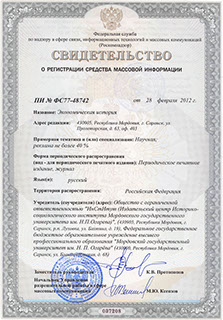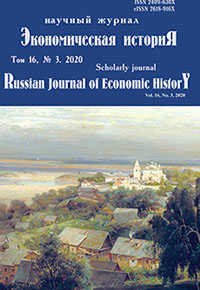Экономическая историЯ
Russian Journal of Economic History
ISSN 2409-630X (Print)
ISSN 2618-916X (Online)
Expert board:
- Scientific Council of RAS on economic history;
- Research and Educational Center «The economic history of Central Russia and the Middle Volga region» of Ogarev Mordovia State University;
- Center of Economic History of Lomonosov Moscow State University
Navigation
Certificate of registration

ISSN 2409-630X (Print), ISSN 2618-916X (Online)
DOI: 10.15507/2409-630X.050.016.202003.304-316
УДК 94(47+57); 338.45
Ivan V. Zykin
Technological Institute (branch) of the National Research Nuclear University (Lesnoy, Russia), e-mail: zivverh@mail.ru
Gross Output and Labour Productivity in the Timber Processing Complex of the USSR in 1927/1928–1937
Introduction. The forest industry played an important role in the economy of the Russian Empire, the Soviet Russia and the Soviet Union and took a significant place in the project of “socialist industrialization” of the late 1920s – early 1940s. One of the key indicators of the functioning of the industry is the cost of gross products, including per worker. The historiography of this topic consists mainly of studies of foreign and domestic scientists on the Soviet economy and works on the history of the regional forest industry. The idea of the dynamics of the cost of gross output of the forest industry during the period of “socialist industrialization” is not formed, which actualizes the analysis of its functioning during the years of active development. The chronological framework of the study is 1927/1928–1937, the period of implementation of the first and second five-year plans. Materials and Methods. The theoretical and methodological basis is the concept of modernization. The peculiarities of statistical accounting of feasibility indicators in the forest industry, the application of “unchanged” prices 1926/1927 are justified. Results. The conclusion was made about the uneven dynamics of the cost of gross products (including per worker) among the components of the forest industry. At a faster pace, labour productivity increased in the forest chemical, furniture industries, the production of standard houses and building parts. The area of timber harvesting showed the slowest pace. According to the results of two five-year plans, the planned values of gross production and labour productivity in the timber industry were not achieved. Discussion and Conclusions. The first five-year plan outlined a significant increase in the cost of gross output of the forest industry and an increase in their share in the industry of the Soviet Union by this indicator. In the second five-year plan, the pace of development of the complex was assumed to be lower than in the country’s industry. With a significant overall increase in the cost of gross output in 1926–1934, labour productivity increased slowly. The use of data on the Ural Economic Region, one of the leading regional timber complexes in the country, demonstrated the preservation of low rates of labour productivity growth in 1935–1938.
Keywords: timber processing complex, industrialization, first five-year plans, gross output, constant prices, labour productivity.
For citation : Zykin I. V. Gross output and labour productivity in the timber processing complex of the USSR in 1927/1928–1937. Ekonomicheskaya istoriya = Russian Journal of Economic History. 2020; 16(3): 304–316. (In Russ.). DOI: 10.15507/2409-630X.050.016.202003.304-316
© Ogarev Mordovia State University. History and Sociology Institute, 2017
68, Of. 411, Bolshevistskaya St., 430005, The editorial office of the scholarly journal «Russian Journal of Economic History»
Tel.: (8342) 24-25-90; 27-07-11, Fax: (8342) 24-25-90, E-mail: jurnal-econom-hist@isi.mrsu.ru
Designed by A. Napalkov, Email: napalkov@isi.mrsu.ru

